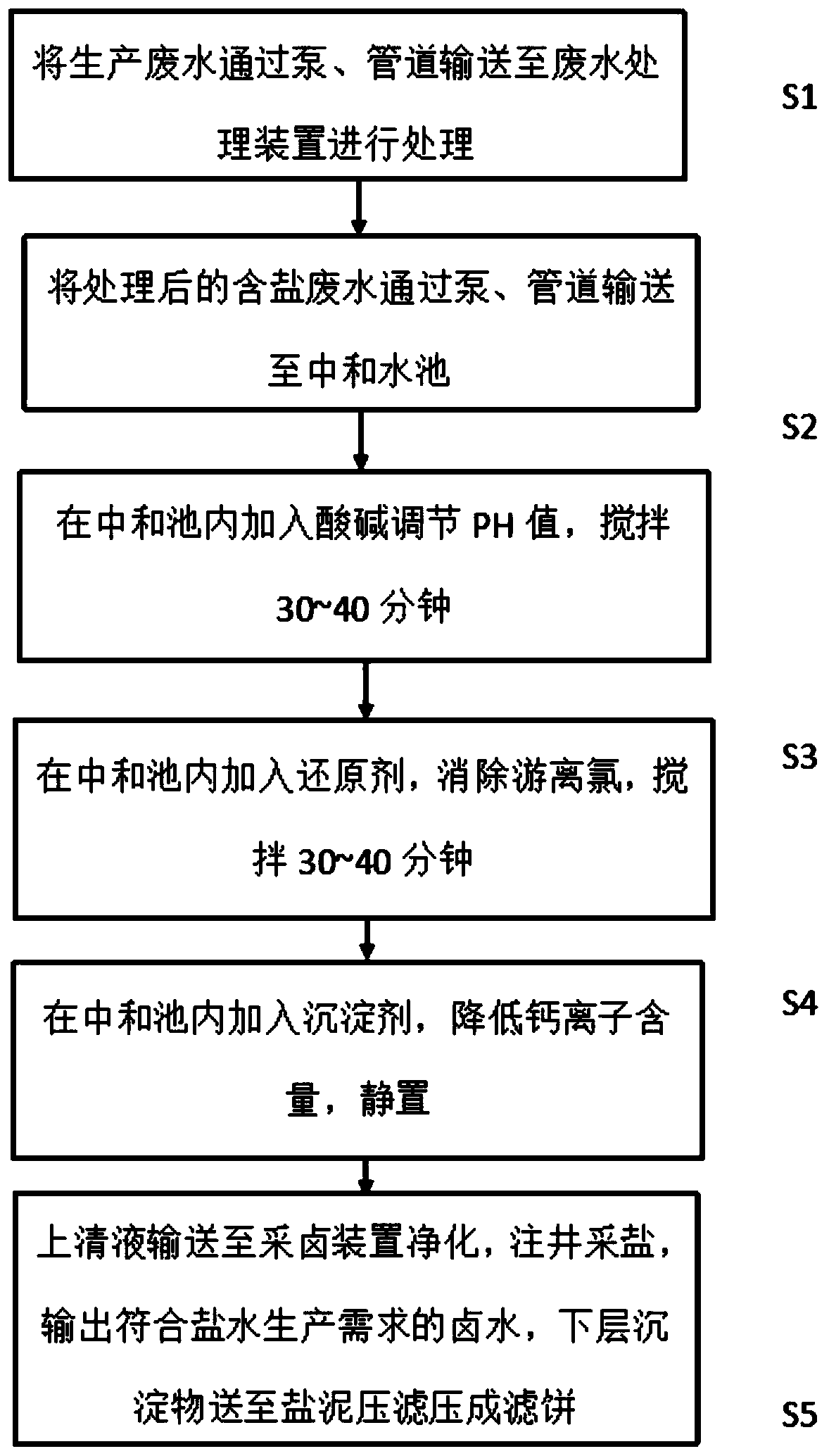Chlor-alkali wastewater treatment method
A wastewater treatment, chlor-alkali technology, applied in water/sewage treatment, water treatment parameter control, neutralized water/sewage treatment, etc., can solve the problems of waste, inability to recover chloride ions, high treatment cost, and achieve low cost and treatment methods. Simple and actionable effects
- Summary
- Abstract
- Description
- Claims
- Application Information
AI Technical Summary
Problems solved by technology
Method used
Image
Examples
Embodiment 1
[0033] A method for treating chlor-alkali wastewater, specifically: transporting chlor-alkali wastewater to a wastewater treatment device to perform "ultrafiltration + nanofiltration membrane" treatment to eliminate organic matter, and obtain concentrated water and saline wastewater after treatment, and the saline wastewater contains free chlorine , excessive calcium ions, recover the desulfurization water from the concentrated water, and transport the saline wastewater to the neutralization tank; add hydrochloric acid, adjust the pH value of the saline wastewater to 9, and stir for 35 minutes; add sodium sulfite, sodium sulfite and The free chlorine in the salty wastewater undergoes oxidation-reduction reaction to remove chlorine, and stir for 30 minutes; add sodium carbonate to the neutralization tank, and the sodium carbonate and calcium ions in the saline wastewater undergo a precipitation reaction. After standing for 2 hours, the neutralization tank The saline wastewater i...
Embodiment 2
[0035] A method for treating chlor-alkali wastewater, specifically: transporting chlor-alkali wastewater to a wastewater treatment device to perform "ultrafiltration + nanofiltration membrane" treatment to eliminate organic matter, and obtain concentrated water and saline wastewater after treatment, and the saline wastewater contains free chlorine , excessive calcium ions, recover the desulfurization water from the concentrated water, and transport the saline wastewater to the neutralization tank; add hydrochloric acid, adjust the pH value of the saline wastewater to 8, and stir for 40 minutes; add sodium sulfite, sodium sulfite and sodium sulfite to the neutralization tank The free chlorine in the salty wastewater undergoes oxidation-reduction reaction to remove chlorine, and stir for 40 minutes; add sodium carbonate to the neutralization tank, and the sodium carbonate and calcium ions in the saline wastewater undergo a precipitation reaction. After standing for 2.5 hours, the ...
Embodiment 3
[0037] A method for treating chlor-alkali wastewater, specifically: transporting chlor-alkali wastewater to a wastewater treatment device to perform "ultrafiltration + nanofiltration membrane" treatment to eliminate organic matter, and obtain concentrated water and saline wastewater after treatment, and the saline wastewater contains free chlorine , excessive calcium ions, recover the desulfurization water from the concentrated water, and transport the saline wastewater to the neutralization tank; add caustic soda, adjust the pH value of the saline wastewater to 7, and stir for 30 minutes; add sodium sulfite, sodium sulfite and sodium sulfite to the neutralization tank The free chlorine in the salty wastewater undergoes oxidation-reduction reaction to remove chlorine, and stir for 35 minutes; add sodium carbonate to the neutralization tank, and the sodium carbonate and calcium ions in the salty wastewater undergo precipitation reaction, and after standing for 3 hours, the neutra...
PUM
 Login to View More
Login to View More Abstract
Description
Claims
Application Information
 Login to View More
Login to View More - R&D
- Intellectual Property
- Life Sciences
- Materials
- Tech Scout
- Unparalleled Data Quality
- Higher Quality Content
- 60% Fewer Hallucinations
Browse by: Latest US Patents, China's latest patents, Technical Efficacy Thesaurus, Application Domain, Technology Topic, Popular Technical Reports.
© 2025 PatSnap. All rights reserved.Legal|Privacy policy|Modern Slavery Act Transparency Statement|Sitemap|About US| Contact US: help@patsnap.com

